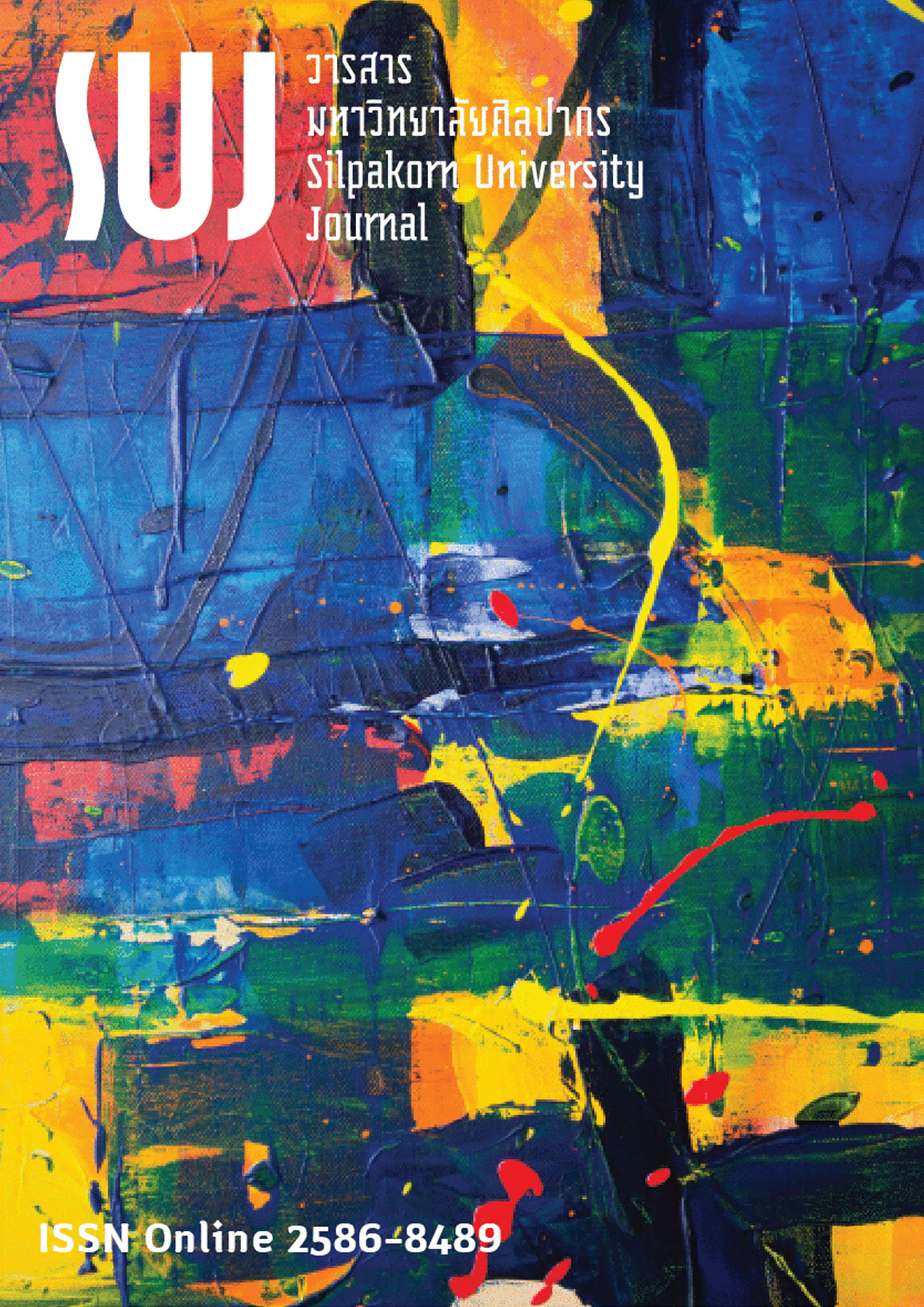สังคีตลักษณ์ และปฏิสัมพันธ์ทางวัฒนธรรมดนตรีจาเป็ยในราชอาณาจักรกัมพูชา (Characteristic and interaction of JA-PEY music culture in Kingdom of Cambodia)
Main Article Content
Abstract
บทความวิจัยเรื่องนี้มีวัตถุประสงค์เพื่อ 1. ศึกษาสังคีตลักษณ์วัฒนธรรมดนตรีจาเป็ย 2. ศึกษาปฏิสัมพันธ์ทางวัฒนธรรมดนตรีจาเป็ย และ 3. ศึกษาบทบาทหน้าที่ของวัฒนธรรมดนตรีจาเป็ยในราชอาณาจักรกัมพูชา ผลการวิจัยพบว่า 1) สังคีตลักษณ์ทางวัฒนธรรมดนตรีจาเป็ย เป็นเครื่องดนตรีประเภทดีด มี 2 สาย มีต้นกำเนิดจากประเทศอินเดีย โดยตั้งสายแบบคู่ 5 คือ สายเอกเสียง โด และสายทุ้มคือ เสียงซอล รูปแบบของบทเพลงในการบรรเลงเป็นบทเพลงสั้น ๆ ไม่มีการบรรเลงซ้ำวนไปวนมาประโยคเพลงมีทั้งประโยคถามและประโยคตอบ บันไดเสียงจัดอยู่ในกลุ่ม G Dorian#11 จังหวะในการบรรเลงมีลักษณะสั้น-ยาว, ช้า-เร็ว แบบไม่คงที่ 2) ปฏิสัมพันธ์ทางวัฒนธรรมดนตรีจาเป็ย พบว่ามีความสัมพันธ์กัน 3 สำนักทางดนตรีที่ได้รับความนิยมได้แก่ ลักษณะการบรรเลงแบบ กง ไณ (គង់ ណៃ) ลักษณะการบรรเลงแบบ ปราชญ์ ฌวน (ទ្ធាចារ្យប្រាជ្ញឈួន) และลักษณะการบรรเลงแบบ มอม ซอน (ម៉ម សុន) และ 3) บทบาทหน้าที่ของเครื่องดนตรีจาเป็ย มีลักษณะเป็นการดำเนินทำนองเพื่อเป็นโครงสร้างหลักของเพลง มีการดีดเก็บทำนองสลับการดีดกรอทำนองและใช้บรรเลงในโอกาสต่าง ๆ ที่เกี่ยวข้องกับพิธีกรรมของคนในสังคมเขมร ประโยชน์ที่ได้จากการศึกษาครั้งนี้ คือ เพื่อเป็นฐานข้อมูลทางดุริยางควิทยาดนตรีแก่ผู้ที่สนใจในประเด็นลักษณะทางการบรรเลงดนตรีจาเป็ยของราชอาณาจักรกัมพูชา รวมถึงการดีดจาเป็ยขั้นพื้นฐาน การนั่ง การวางนิ้ว และเพื่อเป็นฐานข้อมูลทางการวิจัยครั้งต่อไปในประเด็นบทบาทและหน้าที่ของเครื่องดนตรีจาเป็ยที่บรรเลงในวงดนตรีต่าง ๆ รวมถึงบทบาทหน้าที่ของเครื่องดนตรีจาเป็ยในบริบทของสังคม
The objectives of this study were to study the characteristics, the interaction, and the roles and functions of Ja-Pey music culture in the Kingdom of Cambodia. The research findings reveal that Sangkeetalak Ja-Pey is a type of plucked string instruments which originated in India. The instrument has two strings tuned to an interval of fifth’s apart, namely Do and Sol. The melodic phrases are short with no repetitions. The songs are in a question-answer form. The tone scale is classified as G Dorian#11. The rhythm in the song is classified as inconsistently short-long and slow-fast. In addition, the cultural interaction of Ja-Pey music was found to be correlated with three popular music schools: Kong Nai style, Prach Chuan style, and Mom Son style. The roles and functions of the instrument are to conduct melodies to be the song’s main structure. There are upstrokes and downstrokes with an alteration of tremolo which are performed in the rituals in Khmer society. The benefits of this study are to serve as a database of musical instruments for those who are interested in Ja-Pey musical performances of the Kingdom of Cambodia, basic knowledge of Ja-Pey music playing, its sitting position, and finger placement. This study is also served as a research database of the roles and functions of Ja-Pey instruments played in various orchestras as well as in the context of society.
Downloads
Article Details

This work is licensed under a Creative Commons Attribution-NonCommercial-NoDerivatives 4.0 International License.
References
Bophary, V. (2008). Pithi Sampeah Kru Phleng Mahori at the Royal University of Fine Arts, Cambodia. Master’s dissertation, Mahidol University, Nakhon Pathom, Thailand.
Clewley, J. (2000). Cambodia: Heavenly Dancers. In S. Broughton, M. Ellingham, J. McConnacchie, & O. Duane (Eds.), World Music, Volume 2: Latin & North America, Caribbean, India, Asia and Pacific, (pp. 20-23). London: Rough Guides.
Kingkaew, Sippavich. (2019). Chapei Dong Veng: The Cultural Context of Traditional Khmer Music (จาบุีฎงแวง (ចាប៉ីដងវែង) : บริบทวัฒนธรรมดนตรีกัมพูชา). Doctoral dissertation, Srinakharinwirot University, Bangkok, Thailand.
Pikulsri, Chalermsak. (2017). Changes in Music (การเปลี่ยนแปลงทางดนตรี) (1sted.). Khon Kaen: Graduate Textbook Project in the Department of Music, Faculty of Fine and Applied Arts, Khon Kaen University.
Saisingha, Sakchai. (2004). Dvaravati Art, Early Buddhist Culture in Thailand (ศิลปะทวารวดีวัฒนธรรมพุทธศาสนายุคแรกเริ่มในดินแดนไทย). Bangkok: Muang Boran Press.
Vejakorn, Onuma. (2012). Chapei Dang Veng Performance Techniques of KRU JUM CHANG CHAN (กลวิธีการบรรเลงจเปยฎองเวงของครูจุมแสงจันทร์). Master’s dissertation, Chulalongkorn University, Bangkok, Thailand.
Wongthes, Sujit. (1999). Rong Ram Tam-plang : Siam Music and Performance (ร้องรำทำเพลง : ดนตรีและนาฏศิลป์ชาวสยาม) (2nded.). Bangkok: Matichon Book.


